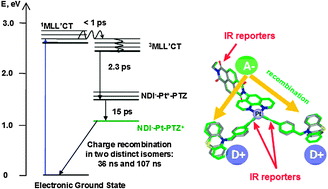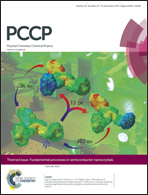Ultrafast photoinduced charge transport in Pt(ii) donor–acceptor assembly bearing naphthalimide electron acceptor and phenothiazine electron donor†
Abstract
Visible light-induced charge transfer dynamics were investigated in a novel transition metal triad acceptor–chromophore–donor, (NDI–phen)Pt(II)(–C![[triple bond, length as m-dash]](https://www.rsc.org/images/entities/char_e002.gif) C–Ph–CH2–PTZ)2 (1), designed for photoinduced charge separation using a combination of time-resolved infrared (TRIR) and femtosecond electronic transient absorption (TA) spectroscopy. In 1, the electron acceptor is 1,4,5,8-naphthalene diimide (NDI), and the electron donor is phenothiazine (PTZ), and [(phen)Pt(–C
C–Ph–CH2–PTZ)2 (1), designed for photoinduced charge separation using a combination of time-resolved infrared (TRIR) and femtosecond electronic transient absorption (TA) spectroscopy. In 1, the electron acceptor is 1,4,5,8-naphthalene diimide (NDI), and the electron donor is phenothiazine (PTZ), and [(phen)Pt(–C![[triple bond, length as m-dash]](https://www.rsc.org/images/entities/char_e002.gif) C–Ph–)], where phen is 1,10-phenanthroline, represents the chromophoric core. The first excited state observed in 1 is a 3MLCT/LL′CT, with {Pt(II)–acetylide}-to-phen character. Following that, charge transfer from the phen-anion onto the NDI subunit to form NDI−–phen–[Pt–(C
C–Ph–)], where phen is 1,10-phenanthroline, represents the chromophoric core. The first excited state observed in 1 is a 3MLCT/LL′CT, with {Pt(II)–acetylide}-to-phen character. Following that, charge transfer from the phen-anion onto the NDI subunit to form NDI−–phen–[Pt–(C![[triple bond, length as m-dash]](https://www.rsc.org/images/entities/char_e002.gif) C)2]+–PTZ2 occurs with a time constant of 2.3 ps. This transition is characterised by appearance of the prominent NDI-anion features in both TRIR and TA spectra. The final step of the charge separation in 1 proceeds with a time constant of ∼15 ps during which the hole migrates from the [Pt–(C
C)2]+–PTZ2 occurs with a time constant of 2.3 ps. This transition is characterised by appearance of the prominent NDI-anion features in both TRIR and TA spectra. The final step of the charge separation in 1 proceeds with a time constant of ∼15 ps during which the hole migrates from the [Pt–(C![[triple bond, length as m-dash]](https://www.rsc.org/images/entities/char_e002.gif) C)2] subunit to one of the PTZ groups. Charge recombination in 1 then occurs with two distinct time constants of 36 ns and 107 ns, corresponding to the back electron transfer to each of the two donor groups; a rather rare occurrence which manifests that the hole in the final charge-separated state is localised on one of the two donor PTZ groups. The assignment of the nature of the excited states and dynamics in 1 was assisted by TRIR investigations of the analogous previously reported ((COOEt)2bpy)Pt(C
C)2] subunit to one of the PTZ groups. Charge recombination in 1 then occurs with two distinct time constants of 36 ns and 107 ns, corresponding to the back electron transfer to each of the two donor groups; a rather rare occurrence which manifests that the hole in the final charge-separated state is localised on one of the two donor PTZ groups. The assignment of the nature of the excited states and dynamics in 1 was assisted by TRIR investigations of the analogous previously reported ((COOEt)2bpy)Pt(C![[triple bond, length as m-dash]](https://www.rsc.org/images/entities/char_e002.gif) C–Ph–CH2–PTZ)2 (2), (J. E. McGarrah and R. Eisenberg, Inorg. Chem., 2003, 42, 4355; J. E. McGarrah, J. T. Hupp and S. N. Smirnov, J. Phys. Chem. A, 2009, 113, 6430) as well as (bpy)Pt(C
C–Ph–CH2–PTZ)2 (2), (J. E. McGarrah and R. Eisenberg, Inorg. Chem., 2003, 42, 4355; J. E. McGarrah, J. T. Hupp and S. N. Smirnov, J. Phys. Chem. A, 2009, 113, 6430) as well as (bpy)Pt(C![[triple bond, length as m-dash]](https://www.rsc.org/images/entities/char_e002.gif) C–Ph–C7H15)2, which represent the acceptor-free dyad, and the chromophoric core, respectively. Thus, the step-wise formation of the full charge-separated state on the picosecond time scale and charge recombination via tunnelling have been established; and the presence of two distinct charge recombination pathways has been observed.
C–Ph–C7H15)2, which represent the acceptor-free dyad, and the chromophoric core, respectively. Thus, the step-wise formation of the full charge-separated state on the picosecond time scale and charge recombination via tunnelling have been established; and the presence of two distinct charge recombination pathways has been observed.



 Please wait while we load your content...
Please wait while we load your content...